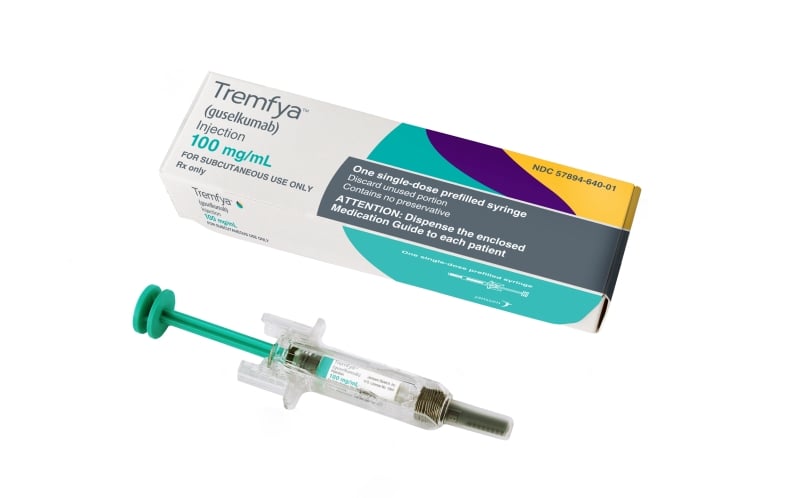UPDATED: As Stelara nears patent cliff, J&J fortifies Tremfya for upcoming IBD showdown
21 May 2024
Clinical ResultDrug ApprovalPhase 3Biosimilar

Preview
Source: FiercePharma
Tremfya’s efficacy looks better but not too different from the results achieved by AbbVie’s rival IL-23 inhibitorIL-23 inhibitor Skyrizi in its own UC maintenance trial. (Johnson & Johnson)
Editor's Note: The story was originally published on May 20 and was updated on May 21 to include Tremfya's data in Crohn's disease.
The biologics market for inflammatory bowel disease is continually getting more competitive, and now Johnson & Johnson’s Tremfya is the latest medicine angling to make a mark in the space.
Tremfya, at two different doses, beat J&J’s own Stelara in patients with moderately to severely active Crohn’s disease (CD) when it came to improvements seen under an endoscope, according to phase 3 results presented at Digestive Disease week (DDW) 2024.
Tremfya’s magnitude of improvement over Stelara appeared smaller when considering clinical remission rates. The newer IL-23 inhibitorIL-23 inhibitor helped 70.3% and 65.4% of patients, respectively, reach clinical remission. The older IL-12/23 blocker managed a 62.9% rate of clinical remission.
Tremfya was also better than placebo on two co-primary endpoints of the GALAXI 2 and GALAXI 3 trials. Both composite endpoints included clinical responses at week 12, along with either clinical remission or endoscopic responses at week 48.
In the increasingly crowded IL-23 space, AbbVie’s Skyrizi was the first treatment to reach CD with an FDA approval in June 2022. Last year, AbbVie put up its own Stelara head-to-head win, showing that 61% of Skyrizi takers achieved clinical remission at week 48, versus 41% for Stelara. Skyrizi also doubled the endoscopic remission rate to 32%.
Also at DDW, Eli Lilly unveiled CD data for its Omvoh, which in October became the first IL-23 drug approved in ulcerative colitis (UC), the other form of inflammatory bowel disease. But the Lilly drug was pitted against placebo and doesn’t yet have Stelara head-to-head data.
Meanwhile, as J&J awaits an FDA approval decision for Tremfya in UC, the company additionally unveiled positive phase 3 data showing the drug works as a maintenance therapy for the disease. The IL-23 inhibitorIL-23 inhibitor helped significantly more patients with moderate to severe, active UC achieve clinical remission after 44 weeks of treatment compared with placebo, according to results from the phase 3 QUASAR maintenance study shared during DDW.
Tremfya’s efficacy looks better but not too different from the results achieved by Skyrizi in its own UC maintenance trial. In the phase 3 COMMAND trial, 40% and 38% of patients who received subcutaneous Skyrizi at 180mg and 360mg every eight weeks, respectively, achieved clinical remission after a year of treatment. The number was 25% for those who transitioned to placebo after Skyrizi infusion as induction.
“These data suggest the potential of [Tremfya] to provide durable, clinical remission and improve important high-bar endpoints such as endoscopic remission to the point of normalization and histologic remission, which represent the kind of progress needed in new treatments for this inflammatory bowel disease,” David T. Rubin, M.D., from University of Chicago and lead investigator of the QUASAR study, said in a statement Monday.
Before the latest maintenance readout, the QUASAR induction study had found that Tremfya led to a 22.6% rate of clinical remission at week 12, versus 7.9% for placebo.
Based on the QUASAR findings, J&J in March filed Tremfya for FDA approval in UC. The company on May 1 said it has applied for both UC and CD with the European Medicines Agency.
European Stelara biosimilars are expected to debut this year, with U.S. copycats expected to be available in early 2025.
Ahead of Stelara biosimilar launches, Tremfya has been gaining traction commercially. In the first quarter, Tremfya sales jumped 26% year over year to $808 million, while Stelara’s sales flattened at $2.45 billion. Tremfya now generates more sales in its approved indications—plaque psoriasis and psoriatic arthritis—than Stelara does in those two fields, J&J CEO Joaquin Duato said on the company’s first-quarter earnings call in April.
For more details,please visit the original website
The content of the article does not represent any opinions of Synapse and its affiliated companies. If there is any copyright infringement or error, please contact us, and we will deal with it within 24 hours.
Organizations
Indications
Targets
Hot reports
Get started for free today!
Accelerate Strategic R&D decision making with Synapse, PatSnap’s AI-powered Connected Innovation Intelligence Platform Built for Life Sciences Professionals.
Start your data trial now!
Synapse data is also accessible to external entities via APIs or data packages. Leverages most recent intelligence information, enabling fullest potential.





